Report on Recent Advances in Wireless Technologies and Applications
VerifiedAdded on 2023/05/23
|6
|817
|122
Report
AI Summary
This report provides an overview of recent advancements in wireless technologies, focusing on WiMAX, Bluetooth Smart, and WiGig. WiMAX is presented as an advancement in broadband wireless connections, offering high bandwidth solutions and wider coverage, but with limitations in remote areas and signal degradation with multiple connections. Bluetooth Smart (4.0) is highlighted for its minimal power consumption and improved authentication, though its range remains limited. WiGig, the latest Wi-Fi standard, promises improved speeds and distances, but struggles with obstacles. The report outlines the strengths and weaknesses of each technology based on their applications, referencing various sources to support its claims. Desklib provides students with access to this document, offering a platform for accessing similar solved assignments and study resources.
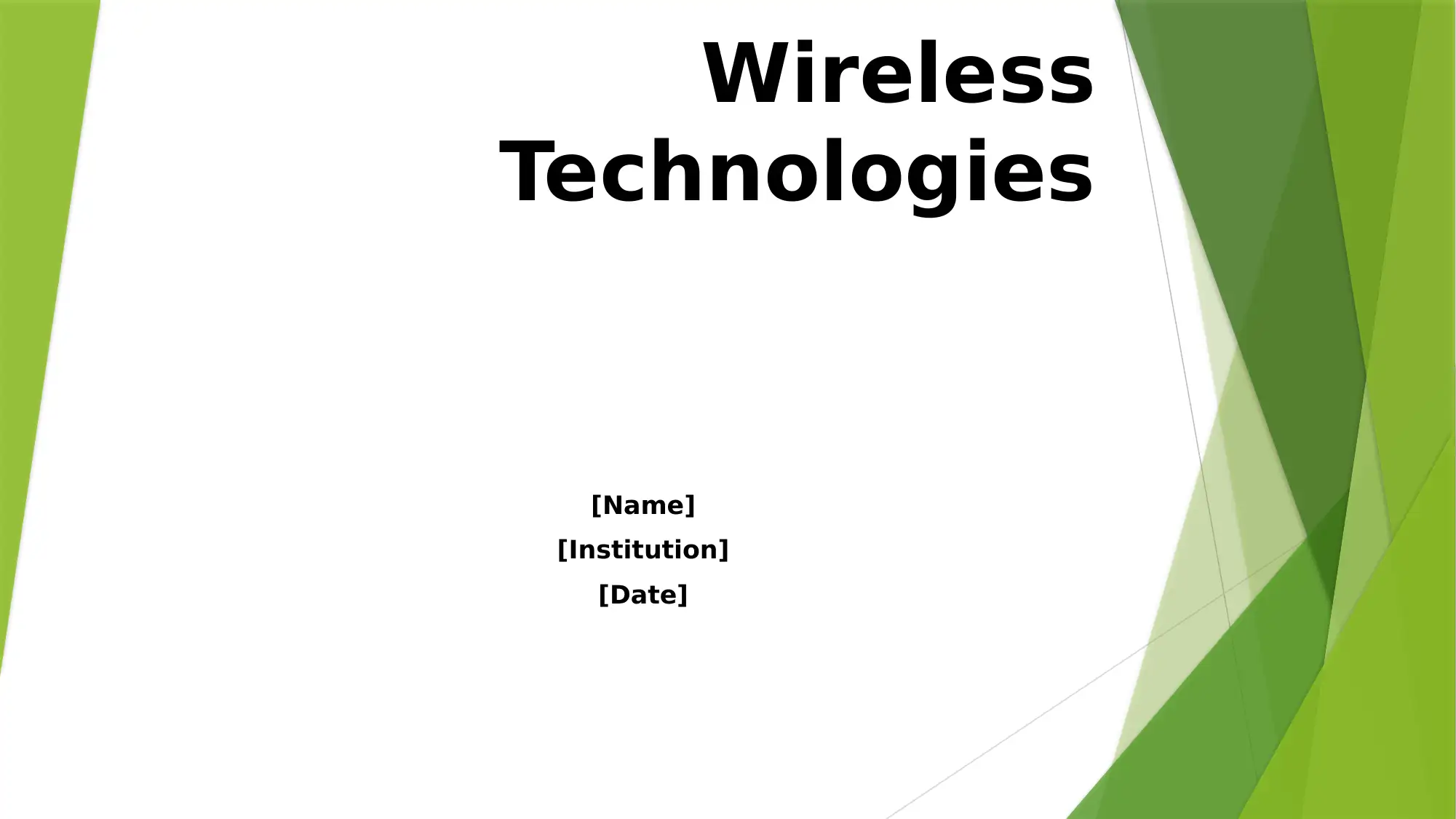
Wireless
Technologies
[Name]
[Institution]
[Date]
Technologies
[Name]
[Institution]
[Date]
Paraphrase This Document
Need a fresh take? Get an instant paraphrase of this document with our AI Paraphraser
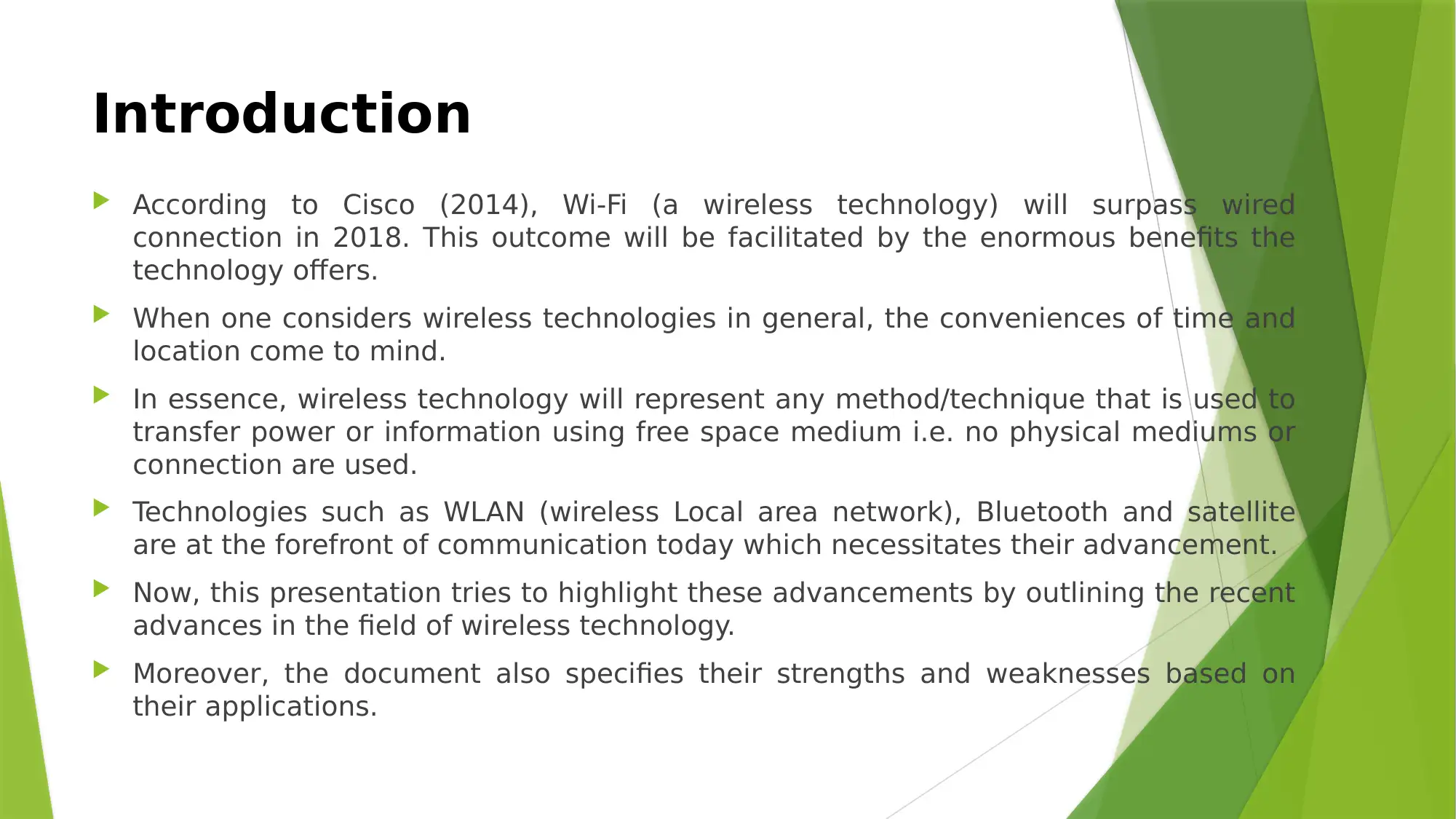
Introduction
According to Cisco (2014), Wi-Fi (a wireless technology) will surpass wired
connection in 2018. This outcome will be facilitated by the enormous benefits the
technology offers.
When one considers wireless technologies in general, the conveniences of time and
location come to mind.
In essence, wireless technology will represent any method/technique that is used to
transfer power or information using free space medium i.e. no physical mediums or
connection are used.
Technologies such as WLAN (wireless Local area network), Bluetooth and satellite
are at the forefront of communication today which necessitates their advancement.
Now, this presentation tries to highlight these advancements by outlining the recent
advances in the field of wireless technology.
Moreover, the document also specifies their strengths and weaknesses based on
their applications.
According to Cisco (2014), Wi-Fi (a wireless technology) will surpass wired
connection in 2018. This outcome will be facilitated by the enormous benefits the
technology offers.
When one considers wireless technologies in general, the conveniences of time and
location come to mind.
In essence, wireless technology will represent any method/technique that is used to
transfer power or information using free space medium i.e. no physical mediums or
connection are used.
Technologies such as WLAN (wireless Local area network), Bluetooth and satellite
are at the forefront of communication today which necessitates their advancement.
Now, this presentation tries to highlight these advancements by outlining the recent
advances in the field of wireless technology.
Moreover, the document also specifies their strengths and weaknesses based on
their applications.
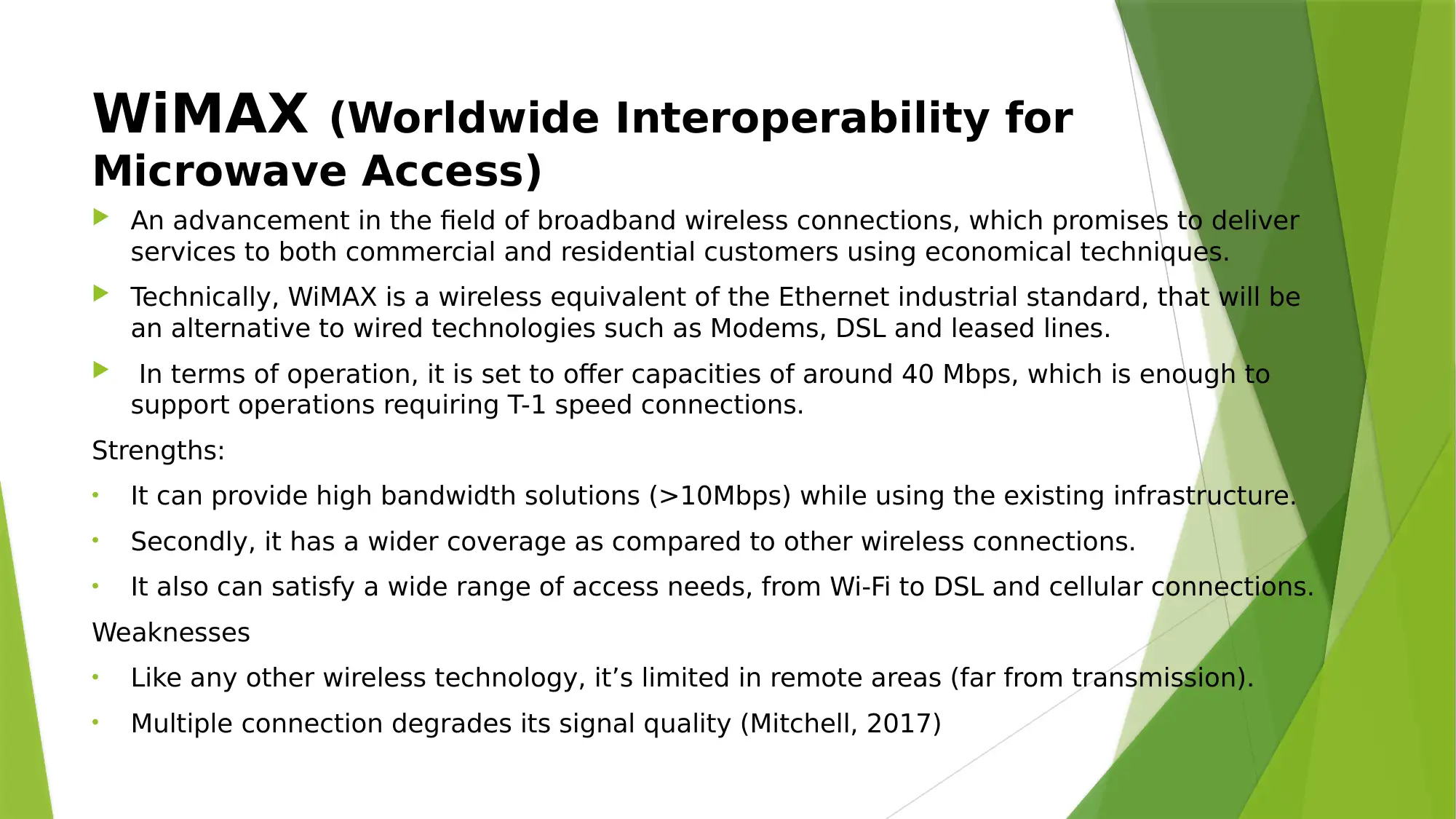
WiMAX (Worldwide Interoperability for
Microwave Access)
An advancement in the field of broadband wireless connections, which promises to deliver
services to both commercial and residential customers using economical techniques.
Technically, WiMAX is a wireless equivalent of the Ethernet industrial standard, that will be
an alternative to wired technologies such as Modems, DSL and leased lines.
In terms of operation, it is set to offer capacities of around 40 Mbps, which is enough to
support operations requiring T-1 speed connections.
Strengths:
• It can provide high bandwidth solutions (>10Mbps) while using the existing infrastructure.
• Secondly, it has a wider coverage as compared to other wireless connections.
• It also can satisfy a wide range of access needs, from Wi-Fi to DSL and cellular connections.
Weaknesses
• Like any other wireless technology, it’s limited in remote areas (far from transmission).
• Multiple connection degrades its signal quality (Mitchell, 2017)
Microwave Access)
An advancement in the field of broadband wireless connections, which promises to deliver
services to both commercial and residential customers using economical techniques.
Technically, WiMAX is a wireless equivalent of the Ethernet industrial standard, that will be
an alternative to wired technologies such as Modems, DSL and leased lines.
In terms of operation, it is set to offer capacities of around 40 Mbps, which is enough to
support operations requiring T-1 speed connections.
Strengths:
• It can provide high bandwidth solutions (>10Mbps) while using the existing infrastructure.
• Secondly, it has a wider coverage as compared to other wireless connections.
• It also can satisfy a wide range of access needs, from Wi-Fi to DSL and cellular connections.
Weaknesses
• Like any other wireless technology, it’s limited in remote areas (far from transmission).
• Multiple connection degrades its signal quality (Mitchell, 2017)
⊘ This is a preview!⊘
Do you want full access?
Subscribe today to unlock all pages.

Trusted by 1+ million students worldwide
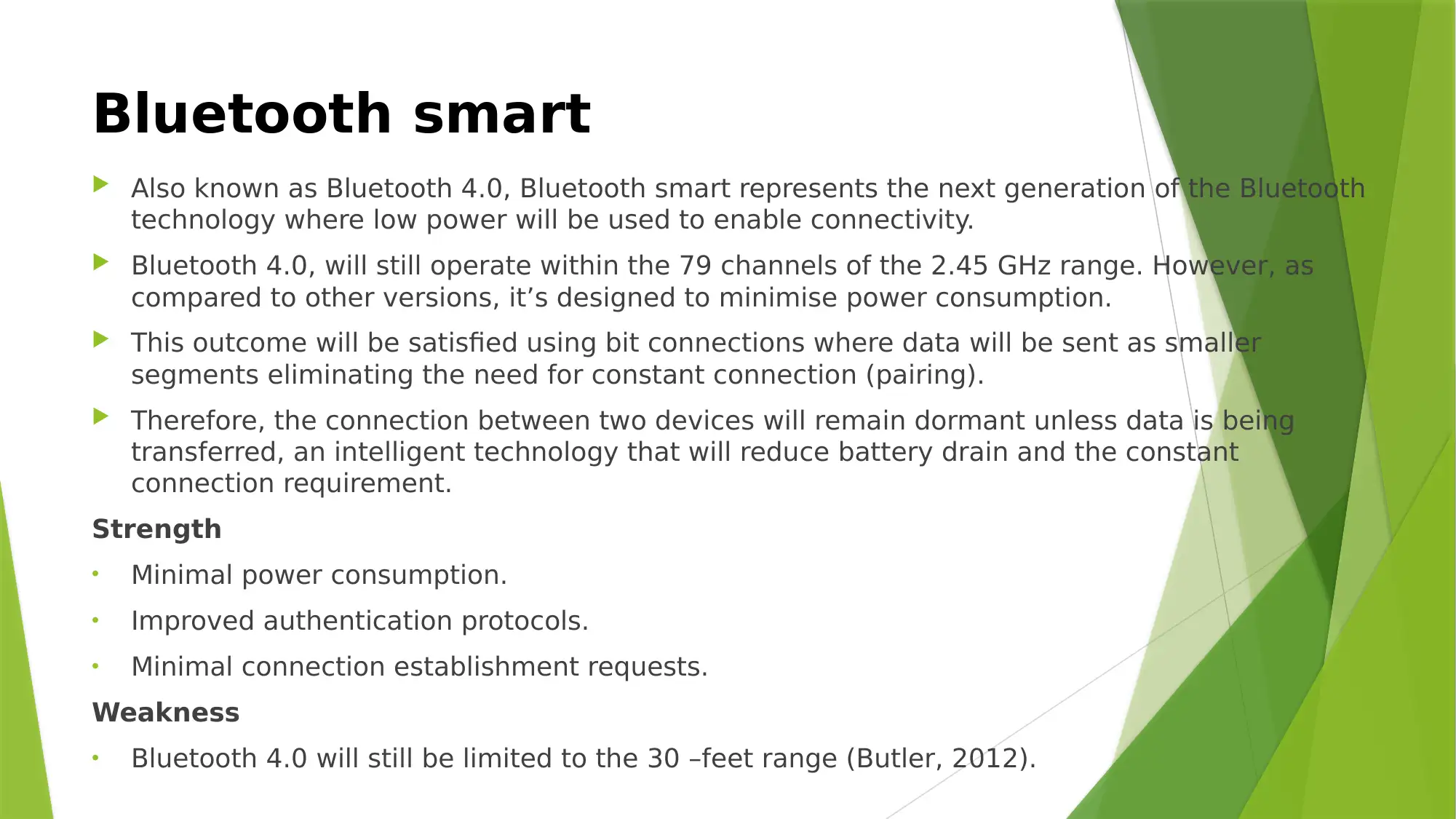
Bluetooth smart
Also known as Bluetooth 4.0, Bluetooth smart represents the next generation of the Bluetooth
technology where low power will be used to enable connectivity.
Bluetooth 4.0, will still operate within the 79 channels of the 2.45 GHz range. However, as
compared to other versions, it’s designed to minimise power consumption.
This outcome will be satisfied using bit connections where data will be sent as smaller
segments eliminating the need for constant connection (pairing).
Therefore, the connection between two devices will remain dormant unless data is being
transferred, an intelligent technology that will reduce battery drain and the constant
connection requirement.
Strength
• Minimal power consumption.
• Improved authentication protocols.
• Minimal connection establishment requests.
Weakness
• Bluetooth 4.0 will still be limited to the 30 –feet range (Butler, 2012).
Also known as Bluetooth 4.0, Bluetooth smart represents the next generation of the Bluetooth
technology where low power will be used to enable connectivity.
Bluetooth 4.0, will still operate within the 79 channels of the 2.45 GHz range. However, as
compared to other versions, it’s designed to minimise power consumption.
This outcome will be satisfied using bit connections where data will be sent as smaller
segments eliminating the need for constant connection (pairing).
Therefore, the connection between two devices will remain dormant unless data is being
transferred, an intelligent technology that will reduce battery drain and the constant
connection requirement.
Strength
• Minimal power consumption.
• Improved authentication protocols.
• Minimal connection establishment requests.
Weakness
• Bluetooth 4.0 will still be limited to the 30 –feet range (Butler, 2012).
Paraphrase This Document
Need a fresh take? Get an instant paraphrase of this document with our AI Paraphraser
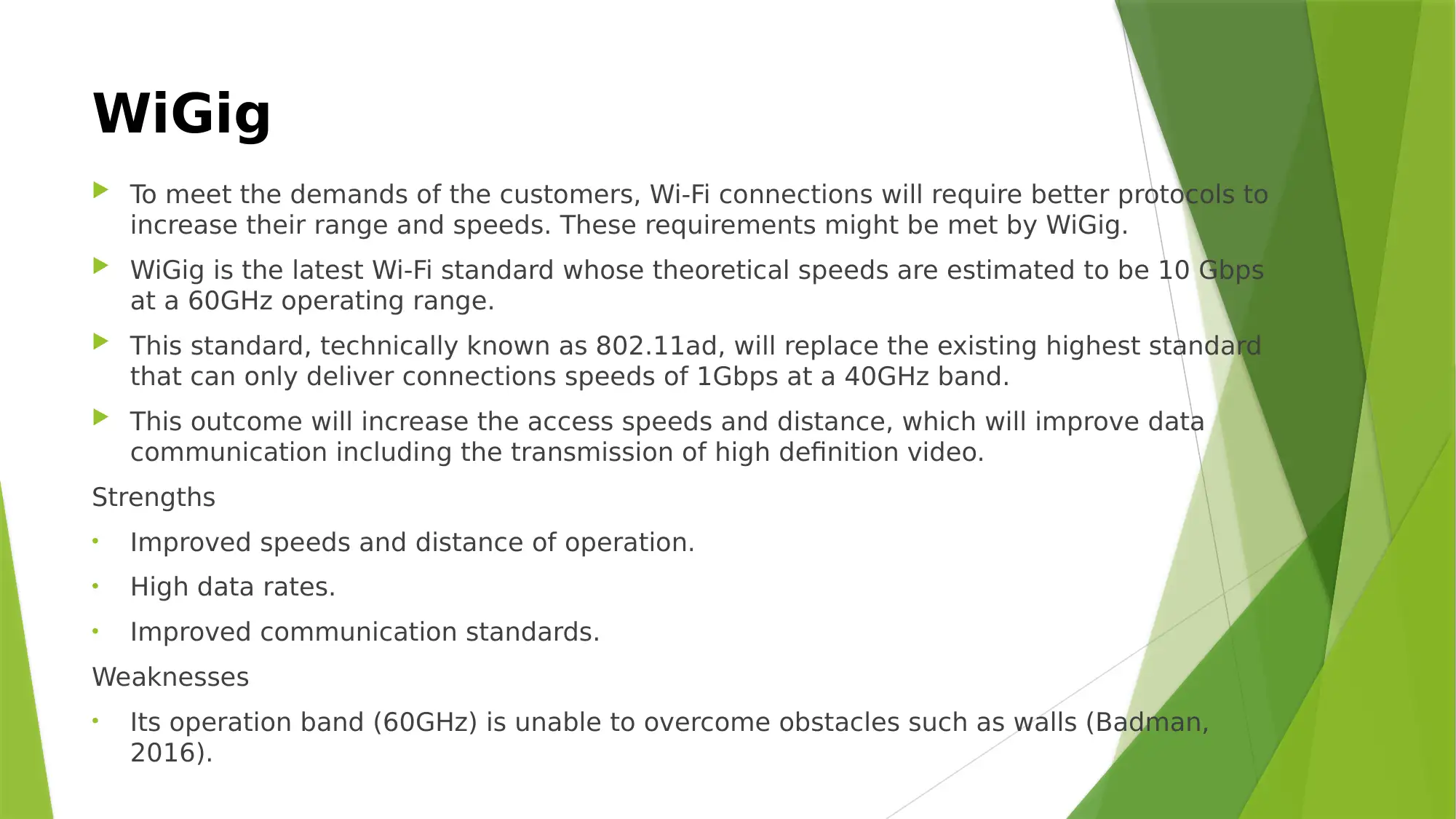
WiGig
To meet the demands of the customers, Wi-Fi connections will require better protocols to
increase their range and speeds. These requirements might be met by WiGig.
WiGig is the latest Wi-Fi standard whose theoretical speeds are estimated to be 10 Gbps
at a 60GHz operating range.
This standard, technically known as 802.11ad, will replace the existing highest standard
that can only deliver connections speeds of 1Gbps at a 40GHz band.
This outcome will increase the access speeds and distance, which will improve data
communication including the transmission of high definition video.
Strengths
• Improved speeds and distance of operation.
• High data rates.
• Improved communication standards.
Weaknesses
• Its operation band (60GHz) is unable to overcome obstacles such as walls (Badman,
2016).
To meet the demands of the customers, Wi-Fi connections will require better protocols to
increase their range and speeds. These requirements might be met by WiGig.
WiGig is the latest Wi-Fi standard whose theoretical speeds are estimated to be 10 Gbps
at a 60GHz operating range.
This standard, technically known as 802.11ad, will replace the existing highest standard
that can only deliver connections speeds of 1Gbps at a 40GHz band.
This outcome will increase the access speeds and distance, which will improve data
communication including the transmission of high definition video.
Strengths
• Improved speeds and distance of operation.
• High data rates.
• Improved communication standards.
Weaknesses
• Its operation band (60GHz) is unable to overcome obstacles such as walls (Badman,
2016).
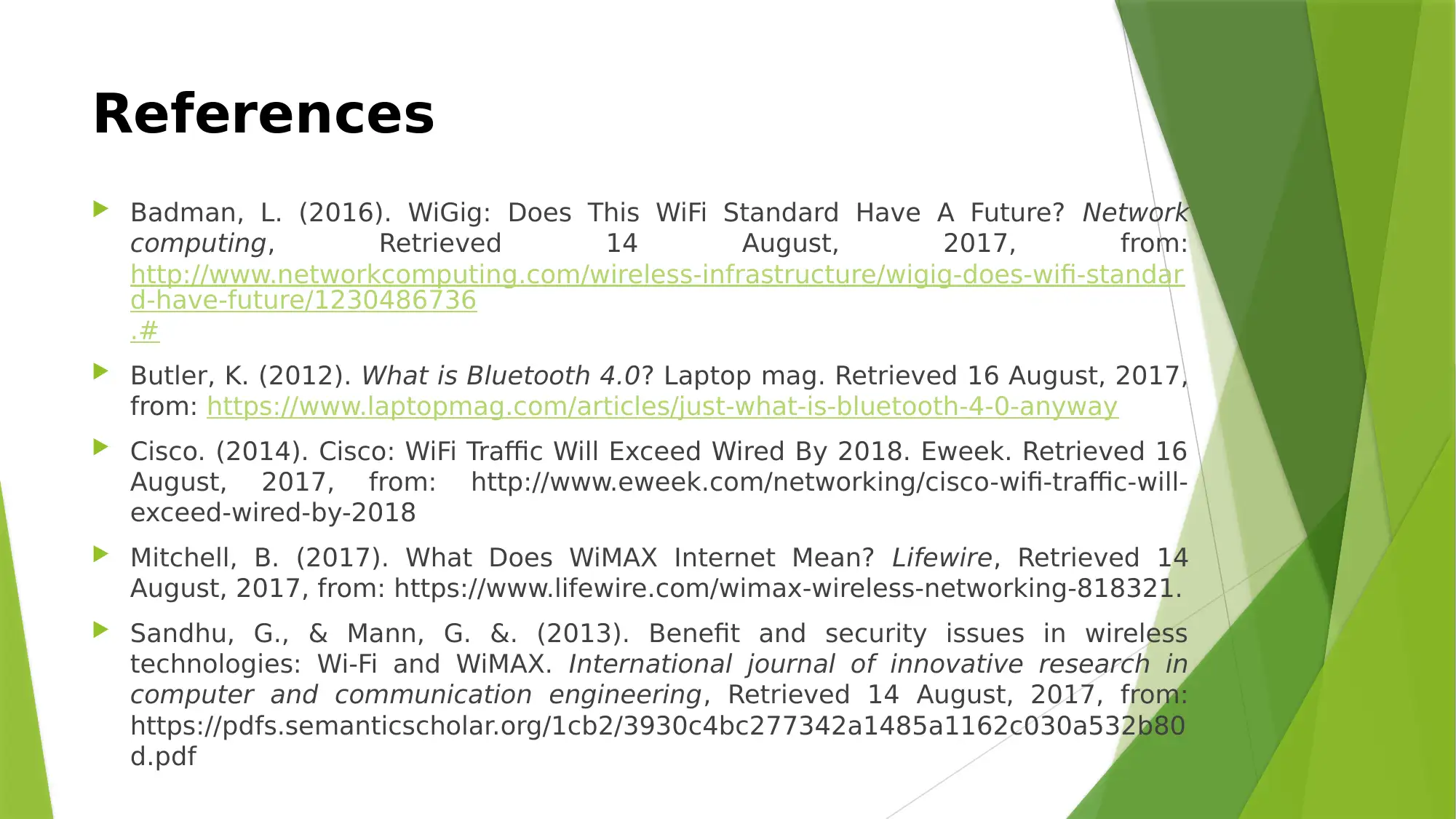
References
Badman, L. (2016). WiGig: Does This WiFi Standard Have A Future? Network
computing, Retrieved 14 August, 2017, from:
http://www.networkcomputing.com/wireless-infrastructure/wigig-does-wifi-standar
d-have-future/1230486736
.#
Butler, K. (2012). What is Bluetooth 4.0? Laptop mag. Retrieved 16 August, 2017,
from: https://www.laptopmag.com/articles/just-what-is-bluetooth-4-0-anyway
Cisco. (2014). Cisco: WiFi Traffic Will Exceed Wired By 2018. Eweek. Retrieved 16
August, 2017, from: http://www.eweek.com/networking/cisco-wifi-traffic-will-
exceed-wired-by-2018
Mitchell, B. (2017). What Does WiMAX Internet Mean? Lifewire, Retrieved 14
August, 2017, from: https://www.lifewire.com/wimax-wireless-networking-818321.
Sandhu, G., & Mann, G. &. (2013). Benefit and security issues in wireless
technologies: Wi-Fi and WiMAX. International journal of innovative research in
computer and communication engineering, Retrieved 14 August, 2017, from:
https://pdfs.semanticscholar.org/1cb2/3930c4bc277342a1485a1162c030a532b80
d.pdf
Badman, L. (2016). WiGig: Does This WiFi Standard Have A Future? Network
computing, Retrieved 14 August, 2017, from:
http://www.networkcomputing.com/wireless-infrastructure/wigig-does-wifi-standar
d-have-future/1230486736
.#
Butler, K. (2012). What is Bluetooth 4.0? Laptop mag. Retrieved 16 August, 2017,
from: https://www.laptopmag.com/articles/just-what-is-bluetooth-4-0-anyway
Cisco. (2014). Cisco: WiFi Traffic Will Exceed Wired By 2018. Eweek. Retrieved 16
August, 2017, from: http://www.eweek.com/networking/cisco-wifi-traffic-will-
exceed-wired-by-2018
Mitchell, B. (2017). What Does WiMAX Internet Mean? Lifewire, Retrieved 14
August, 2017, from: https://www.lifewire.com/wimax-wireless-networking-818321.
Sandhu, G., & Mann, G. &. (2013). Benefit and security issues in wireless
technologies: Wi-Fi and WiMAX. International journal of innovative research in
computer and communication engineering, Retrieved 14 August, 2017, from:
https://pdfs.semanticscholar.org/1cb2/3930c4bc277342a1485a1162c030a532b80
d.pdf
⊘ This is a preview!⊘
Do you want full access?
Subscribe today to unlock all pages.

Trusted by 1+ million students worldwide
1 out of 6
Related Documents
Your All-in-One AI-Powered Toolkit for Academic Success.
+13062052269
info@desklib.com
Available 24*7 on WhatsApp / Email
![[object Object]](/_next/static/media/star-bottom.7253800d.svg)
Unlock your academic potential
Copyright © 2020–2025 A2Z Services. All Rights Reserved. Developed and managed by ZUCOL.





